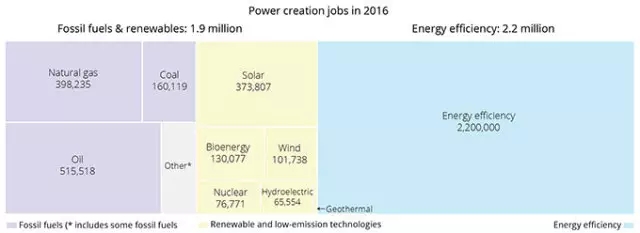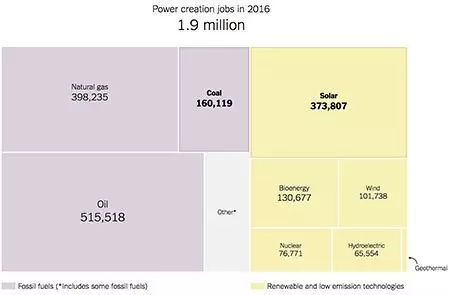中国储能网讯:纽约时报最近报道,太阳能行业从业人数已经超过了煤炭行业。去年,煤炭行业创造的就业岗位为398,235个,而太阳能行业为373,807个,二者已经基本持平。但是更为有趣的是,能源效率行业创造的就业岗位为2,200,000个,远远超过两者之和。在基础能源服务交付过程中,提取、转换、运输、传输和终端使用各个环节都会产生潜在的损耗。提升整体系统能源效率的机会存在于每一环节之中。如果能源服务交付更加高效,可再生能源便能够在一次能源供给中发挥更大的作用。随着可再生能源的比例增加,提供同等水平的能源服务所需的一次能源就相应减少,从而最大程度地降低了整个系统的环境和经济成本。
The New York Times recently reported that the solar industry now employs more people than the coal industry. It made the point well by featuring the accompanying graphic, based on Department of Energy data that track employment in various energy sectors:

This finding is interesting for a number of reasons, not least of which is the fact that the administration has been emphasizing its intention to revitalize the coal industry. If the number of people employed in a sector is the measure of how much attention it should receive, the implication of the Times piece is that solar should be getting more.
As big as the solar vs. coal story is, the Times missed the even bigger story. Because, while it’s true that the solar industry employs more people than coal, it’s also true that energy efficiency employs more people than both of them combined.

In fact, as our updated graphic shows, energy efficiency employs more people than all the other energy sectors combined. The DOE numbers, derived from a methodology similar to the one used by the Bureau of Labor Statistics for official employment reports, are the best estimates we have for employment in energy efficiency. As we noted in a prior post, such tracking is much trickier for efficiency than it is for traditional and alternative energy sectors, because energy efficiency is not a sector in the way that steel or auto manufacturing is. This makes it difficult to estimate energy efficiency employment, so we greatly appreciate DOE tracking these numbers so rigorously.
Solar power has always had a certain cachet to it: it’s often what comes to mind first when people think about emerging energy technology. But energy efficiency, doing more with less, has long been one of the largest, if largely invisible, sources of energy we have.
In that sense, there’s nothing new about how important the efficiency industry is, so the Times may not think it’s newsworthy. But if we are going to talk about how large the various energy industries are, it makes sense to include the largest one.





